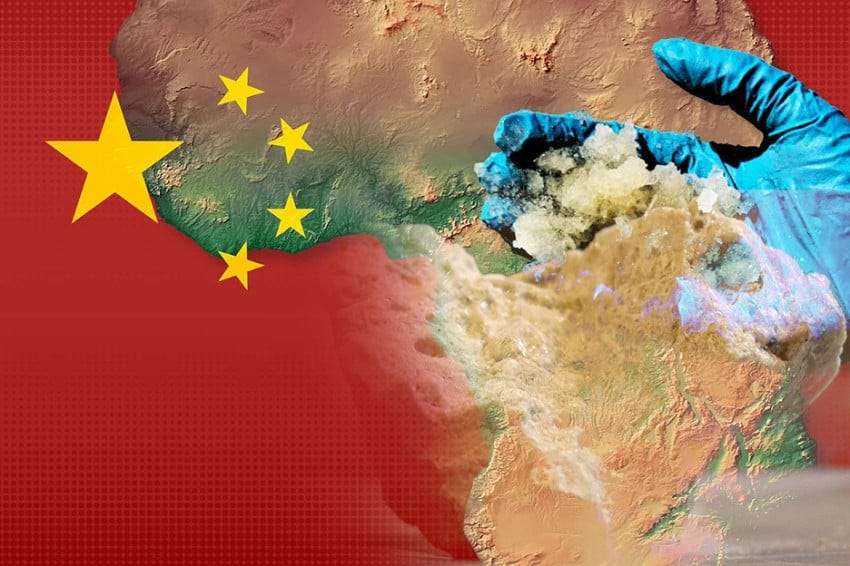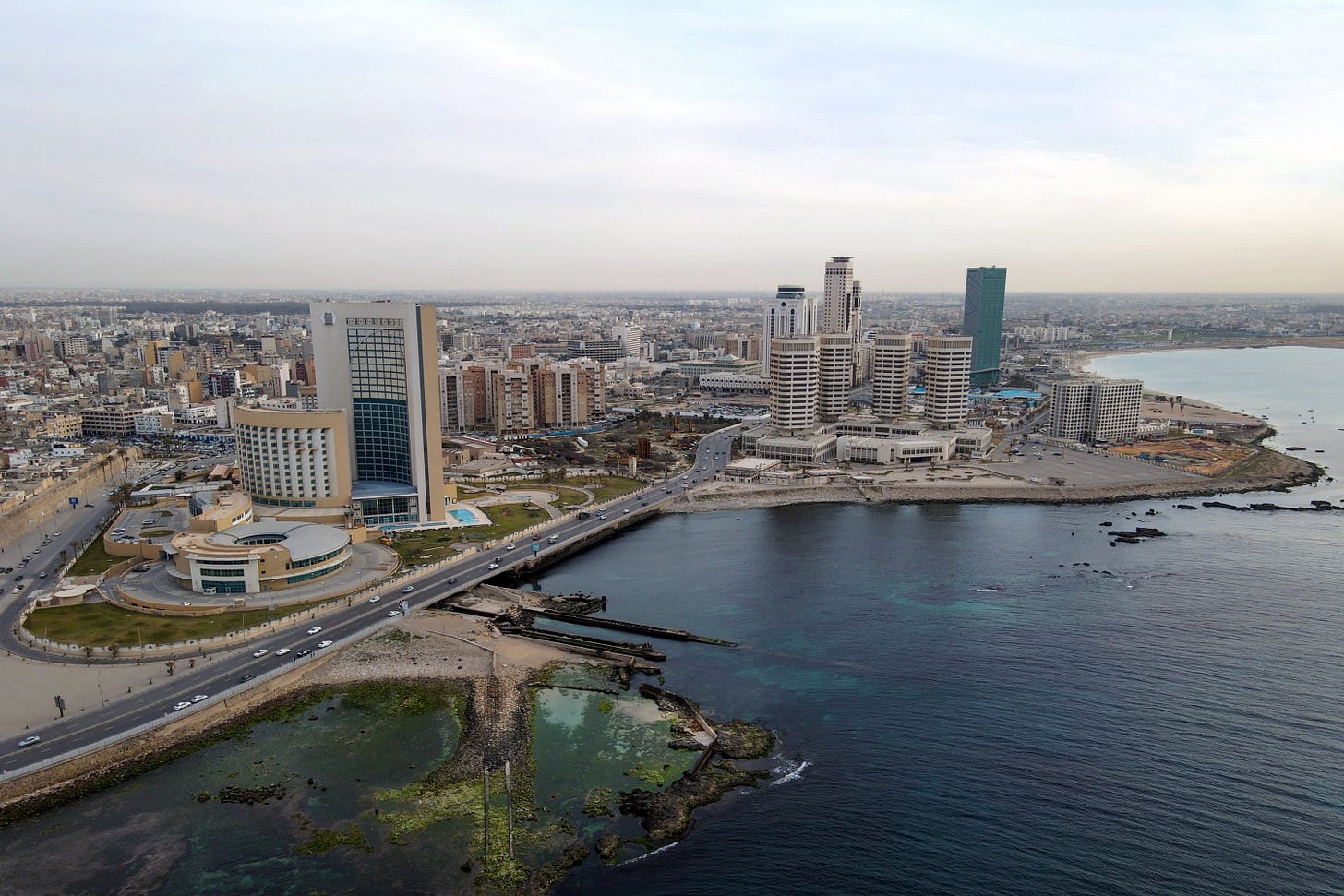China's Expanding Strategic Footprint in Libya: Energy, Infrastructure, and a New Gateway to Europe
Information from sources inside Libya suggests that China is gaining a strong foothold on NATO's southern flank.
Over the past decade, China has steadily increased its engagement across North Africa, with Libya emerging as a centerpiece of Beijing's expanding geopolitical and economic ambitions. As part of its global Belt and Road Initiative (BRI), China is accelerating multi-sectoral investments in energy, infrastructure, and logistics in eastern Libya. These developments reflect a broader effort by China to reshape trade routes, supply chains, and political alignments in the Mediterranean and sub-Saharan Africa. Libya’s east, under the control of Field Marshal Khalifa Haftar’s Libyan National Army (LNA), has become a focal point for negotiations that could transform the region into a critical hub for Sino-African and Sino-European trade.
Strategic Location and Investment Potential
Tobruk, a port city on Libya’s eastern coast, is at the center of Chinese plans. Its strategic location—less than 400 kilometers from Crete and southern Europe—offers a rare combination of geographic proximity and maritime potential. Historically, Tobruk has served as a strategic military and trading post since the Roman era, and later as the site of a pivotal World War II battle. Now, the city is poised to regain international importance, this time as a commercial and energy transit node.
Unlike many southern European ports, such as Genoa, Piraeus, and Barcelona, which lack the draft depth to accommodate ultra-large container vessels, Tobruk’s natural deep-water port positions it as a gateway to Europe. According to our sources inside Libya, Chinese strategists have identified Tobruk as a linchpin for addressing Europe’s port capacity constraints. A multi-phase Chinese investment plan envisions Tobruk as a logistics megahub. At its core is a proposed $10 billion oil refinery capable of processing 500,000 barrels per day. The refined products would be exported to European markets, securing an alternative and stable energy source for the continent. If Haftar's approval is secured, Chinese stakeholders are prepared to invest even more extensively, potentially surpassing $50 billion in total commitments across Libya in the near- to medium-term.
This refinery project is not standalone. Our sources suggest that China envisions Tobruk as an integrated logistics platform that includes fuel storage facilities, transshipment terminals, and supply depots for both maritime and overland transport. The city’s unique geographic location gives it direct access to the Suez Canal, the eastern Mediterranean, and central Africa, creating a web of interlocking trade and supply chains.
Port, Airport, and Logistics Expansion
Alongside the refinery, Chinese companies plan to expand and modernize Tobruk’s port, transforming it into a transshipment hub. Large vessels would dock and offload goods, which would then be transferred to smaller ships for distribution to European destinations—offering a strategic workaround for European port limitations. The port upgrade would include container terminals, bunkering facilities, and customs infrastructure to facilitate seamless trade flows.
China has also proposed upgrading Al-Adem Airport, located adjacent to the Tobruk port. Once the largest British Royal Air Force base globally and now controlled by Haftar’s forces and used by Russian military personnel, Al-Adem is slated to become a critical logistics hub. The airport would integrate with sea and land transport systems, serving as both a civilian cargo and refueling station and a potential dual-use facility with strategic implications. Fuel produced at the Tobruk refinery could be stored and distributed via this air hub, bolstering China’s aviation and military logistics.
These combined port and airport projects would create a modern, multi-modal logistics hub in Tobruk, from which China could control the flow of goods and energy into southern Europe. Strategically, it would give Beijing an unparalleled foothold on NATO's southern flank.
While Haftar has not yet formally approved the projects, our sources suggest Chinese officials are offering generous terms and may request Russian mediation to overcome U.S. concerns. Haftar's hesitancy underscores Libya’s fragile geopolitical balance, but also highlights the stakes of deeper Chinese engagement.
Rail, Roads, and Cross-Regional Linkages
China’s ambitions extend far beyond Libya’s Mediterranean coast. As Egypt constructs a 2,000-kilometer high-speed rail network connecting Ain Sokhna on the Red Sea to Marsa Matruh on the Mediterranean, Chinese-backed plans to extend this corridor into eastern Libya would effectively link Tobruk and Benghazi to the Red Sea. This east-west transnational rail connection would create a seamless land bridge from Libya’s key eastern ports through Egypt to Asia-facing shipping routes. The China Railway International Group (CRIG), supported by the Singapore-based BFI Management Consortium and in partnership with Siemens, has signed a memorandum of understanding with Libyan Railroads to explore building this railway from Benghazi to Marsa Matruh via the Musaid border crossing. With an estimated cost of up to $20 billion, the project reflects the scale of ambition and the complexity of terrain, engineering, and cross-border coordination required.
BFI Management Consortium plays a pivotal role in advancing China’s infrastructure ambitions in Libya. Acting as CRIG’s exclusive partner, BFI has facilitated high-profile agreements across both eastern and western Libya, including planned rail and metro systems in Benghazi and Tripoli. Formed as a special-purpose vehicle for Libyan development, BFI brings together global engineering firms such as Arup and Siemens, providing both technical expertise and political risk insulation. Its involvement underscores the strategic coordination between Chinese state-owned enterprises and international partners, and its operations serve as a critical conduit for Beijing’s expanding logistical and commercial presence in North Africa.
These rail lines are not just about transit—they represent a new spine of connectivity through North Africa. Designed to streamline the movement of goods and people between Asia, Africa, and Europe, these projects are also aimed at opening up future corridors south into Chad and Sudan. In doing so, China seeks to build a vertically integrated trade route that bypasses traditional maritime chokepoints and strengthens its position in emerging African markets, all while using Libya as a continental gateway.
Energy Finance and Institutional Frameworks
To facilitate these complex infrastructure and energy investments, eastern Libya has approved the establishment of the Libyan Bank for Energy and Mining. Its director, Juma Jaballah, has disclosed plans to bring in substantial Chinese capital and is currently awaiting Central Bank of Libya approval for a SWIFT code to begin international transactions.
This development underscores China’s preference for building institutional foundations alongside infrastructure. The bank would serve as the financial conduit for refinery construction, port upgrades, and associated service contracts. It is expected to play a pivotal role in easing capital flows and ensuring compliance with international norms, even as Libya remains politically divided.
Kerui Petroleum, a major Chinese oil services firm, has already begun preliminary studies for the Tobruk refinery under contract from Benghazi’s Ministry of Investment. This underscores the operational readiness of Chinese firms to move forward with detailed planning, even as geopolitical approvals remain pending.
In support of this growing partnership, a high-level Libyan delegation—led by one of Field Marshal Haftar’s sons and representing the Fund for the Development and Reconstruction of Libya—recently traveled to China to advance multiple avenues of cooperation. The delegation held meetings with leading Chinese companies, including Huawei and the China Energy Engineering Corporation (CEEC), to discuss a wide array of projects spanning telecommunications, energy infrastructure, and logistics. Notably, according to our sources inside Libya, Huawei is already leading the rollout of a dedicated telecom network in eastern Libya through a joint venture with local authorities, with the system currently in the testing stage. These developments highlight China’s deepening multi-sector engagement in Libya’s east.
Link to Africa: Roads to Chad and Sudan
China’s vision for Libya transcends national borders. With Africa’s population set to double by 2050, Beijing aims to deepen trade routes that bypass maritime chokepoints like the Suez Canal. Tobruk’s transformation includes plans to extend highway and logistics corridors southward into Chad and Sudan. These overland routes would allow Chinese-manufactured goods to reach African interior markets quickly and cost-effectively.
In return, China would gain access to African raw materials—oil, rare earth elements, and agricultural goods—transported north to Tobruk for processing and export. This multimodal corridor strategy mirrors similar Chinese projects in East Africa, such as the Mombasa-Nairobi-Addis Ababa corridor.
Historical and Geopolitical Context
China’s interest in North Africa is not new. Since the 1960s, Beijing has maintained a presence in Africa, supporting liberation movements and later pivoting to infrastructure and trade. Libya, once marginalized due to internal conflict, is now reemerging as a candidate for strategic partnership. China’s non-interference policy and track record of dealing with non-Western regimes appeal to Haftar’s administration, which remains internationally unrecognized.
Importantly, the eastern region of Libya—historically known as Cyrenaica—played a pivotal role in the Allied campaign during World War II, serving as a key staging ground in the fight against Nazi Germany and Fascist Italy. The region’s legacy as a frontline in the defense of liberal democracy underscores the strategic importance of its alignment today. In the context of growing Chinese and Russian activity, many Western analysts argue that restoring Libyan unity under a government aligned with Western institutions is not only a matter of regional stability but a vital component of broader transatlantic security.
Meanwhile, Libya’s fractured governance deters Western investment and engagement. The United States has prioritized counterterrorism and migration control over state-building in Libya, while the EU remains divided over the best approach. The absence of cohesive Western policy has opened the door to alternative actors—including Russia, Turkey, and increasingly, China.
Implications for European Energy Security
The implications of this Chinese pivot toward Libya for European energy security are profound. Europe’s ongoing energy diversification efforts, especially since the Russia-Ukraine war, have made the continent more reliant on alternative sources from the Middle East and North Africa. If Beijing gains control over a large-scale refinery in Tobruk and the associated port infrastructure, it will possess significant influence over supply chains feeding Europe.
This is not just about access to oil. With the ability to refine, store, and transport energy products directly from North Africa to Europe, China could dictate pricing, volume, and prioritization in times of crisis. Such leverage would challenge Europe's energy autonomy and increase its dependency on Beijing at a time when the transatlantic alliance is already under strain.
Additionally, China's control over container logistics through Tobruk would provide Beijing with leverage over not just energy, but manufactured goods and critical technologies. The dual-use airport, coupled with surveillance and digital infrastructure, could also serve intelligence and military interests.
Strategic Consequences and Outlook
Should Haftar approve the Chinese proposals, Libya would become the western anchor of a vast, China-led logistical and energy network spanning the Indian Ocean, the Red Sea, and the Mediterranean. The Tobruk refinery and associated infrastructure would give Beijing new leverage over European energy markets, especially as the EU seeks to diversify away from Russian gas.
Moreover, the dual-use nature of Tobruk’s upgraded airport and port could extend Chinese naval or intelligence capabilities into the Mediterranean. This possibility has already raised concerns in some NATO circles, although no formal opposition has been articulated.
If successful, China’s Libya strategy would reshape Eurasian supply chains and trade flows. It would also signal a shift in the balance of soft power and strategic influence in North Africa, with potentially profound implications for Europe’s energy security and geopolitical autonomy.
Libya may appear a fragile and fractured state, but to Chinese planners, it represents a gateway—one with the potential to tie Africa, Europe, and Asia together under a new global trade architecture led by Beijing.








